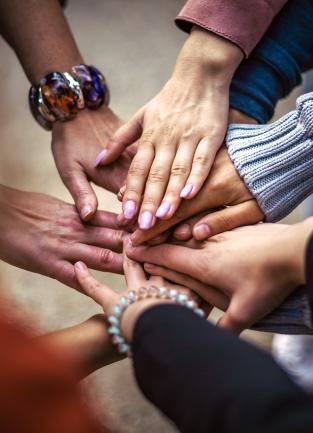Domestic Violence Awareness Month: The Importance of 1994's Violence Against Women Act (VAWA)

October 24, 2025
Domestic Violence Awareness Month has been taking place every October since 1981 to bring awareness to this ongoing issue and unite organizations to work together to end domestic violence.
Domestic violence, or intimate partner violence, is a pattern of abusive behavior centered on power and control between two people who are currently in or have had a relationship. An intimate partner can be a current or former spouse, domestic partner, cohabitant, dating partner, or a person you share a child with. Domestic violence can happen to any person and does not discriminate between race, gender, or sexual orientation. The different types of domestic violence include physical, sexual, psychological, emotional, economic, and technological abuse. According to the National Domestic Violence Hotline, 1 in 3 women and 1 in 4 men in the U.S. have experienced some type of intimate partner violence in their lifetime.
Today, the issue of domestic violence is closely monitored by advocacy organizations like the National Domestic Violence Hotline and the National Coalition Against Domestic Violence. However, the big shift in creating a legal pathway for domestic violence victims came about with the 1994 Violence Against Women Act, signed into law by President Clinton to address gender-based violence including domestic violence, sexual violence, dating violence, and stalking.
Before the VAWA Act of 1994, domestic violence issues were treated as a “family matter,” something to be handled privately with no law enforcement interference. VAWA recognized that gender-based violence needed to be held accountable. VAWA addressed inter-state domestic violence offenses and provided funding for transitional housing, shelter, and advocacy programs to combat domestic violence. It offered protections for battered immigrants to self-petition for citizenship and gave grants towards trainings and education for police officers, attorneys, judges and many in the legal system to promote the creation of a legal pathway for domestic violence victims. VAWA helped to promote Community Coordinated Responses to domestic violence, uniting diverse individuals including police officers, judges, victim advocates, and healthcare professionals to work together to address this ongoing issue.
According to womenslaw.org, one of VAWA’s far-reaching properties concerns the fact that, “a valid California protection [restraining] order that meets federal standards, can be enforced in another state.” In California, “the Domestic Violence Prevention Act, codified in California Family Code sections 6200 to 6460, was designed to protect victims of domestic violence and to allow them an expedited means of obtaining a restraining order against their alleged perpetrator (45 Los Angeles Lawyer 11*).” The courts recognized, at the time of the DVPA’s codification, that victims could not wait for courts to deliberate before acting to intervene in dangerous domestic violence situations. A restraining order under the DVPA can be enforced if it has these properties (information from womenslaw.org):
- It was issued to prevent violent or threatening acts, harassing behavior, or sexual violence, or it was issued to prevent another person from coming near you or contacting you (18 U.S.C. § 2266(5))
- The judge that gave the order had power (jurisdiction) over the people and case; in other words, the judge had the authority to hear the case; and
- The abuser received notice of the order and had an opportunity to go to court to tell his/her side of the story.
- In the case of ex-parte temporary and emergency orders, the abuser must receive notice and have an opportunity to go to court to tell his/her side of the story at a hearing that is scheduled before the temporary order expires. (18 U.S.C. § 2265(a), (b))
The Violence Against Women act is renewed every 5 years; the latest renewal in 2022 addressed the issue of availability of sexual assault forensic exams and untested exam kits, cybercrime and the non-consensual distribution of photos, protections for tribal communities in the expansion of jurisdiction over non-Native perpetrators of sexual and domestic violence, as well as funds to help stop the cycle of abuse with youth exposed to domestic violence, and many more. With each renewal, VAWA works to close the gaps within the domestic violence legal system, like the LGBTQIA+ community and elder violence. Though not perfect, VAWA’s impact on helping to end domestic violence is monumental. As a Library Assistant, being able to offer a variety of community resources and pathways for legal assistance relating to domestic violence is huge. It is important to stay informed and continue to spread awareness about Domestic Violence.
By Sofia Orea and Yanis Ait Kaci Azzou, Library Assistants
RCLL Domestic Violence Resources (PDF, 10/2025): English | Español
Riverside County Sheriff: Temporary Restraining Order (Domestic Violence)
References:
"Protecting the Freedom for Women to be Free From Violence: The Violence Against Women Act Endures," 22 Widener L. Rev. 267
"The Evolution of a National Response to Violence Against Women," 24 Hastings Women's L.J. 429
"Sixth Annual Review of Gender and Sexuality Law: II. Criminal Law Chapter: Domestic Violence and the Federal Government," 6 Geo. J. Gender & L. 405
"Department: Practice Tips: New Domestic Violence Restraining Order Precedent," 45 Los Angeles Lawyer 11
*These articles can be accessed on Lexis+ or Westlaw/Westlaw OnePass. See our "Legal Databases" page for more information.











